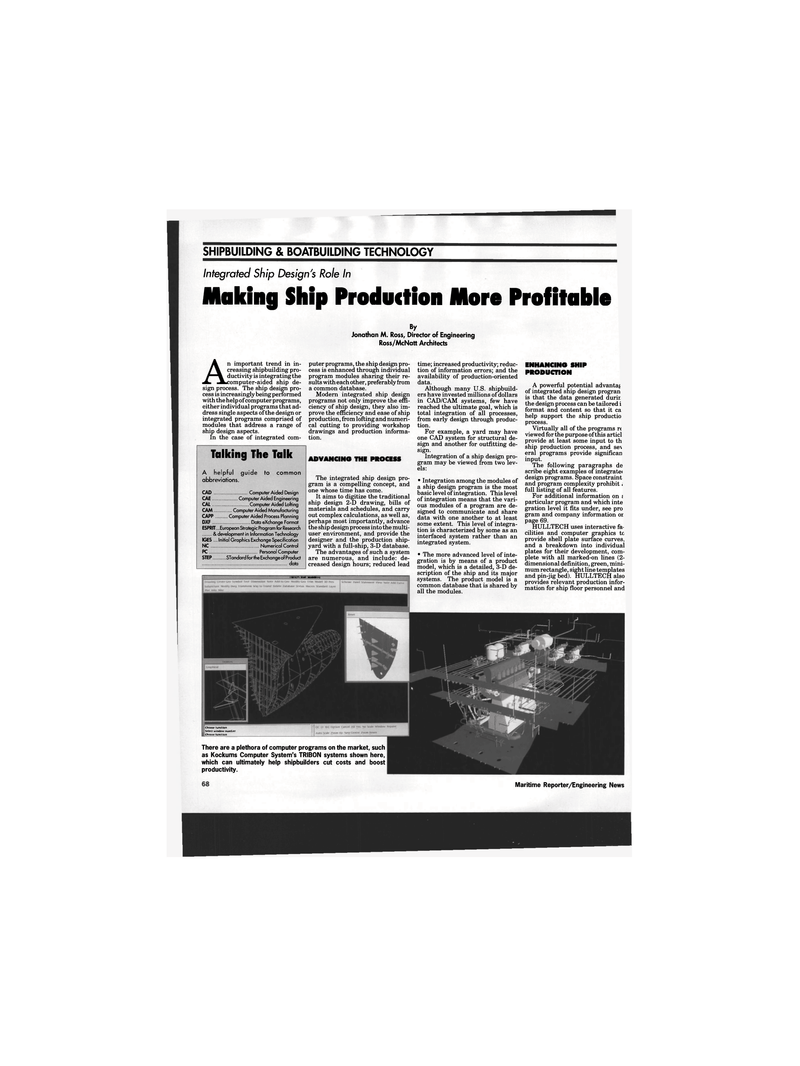
Page 58: of Maritime Reporter Magazine (February 1994)
Read this page in Pdf, Flash or Html5 edition of February 1994 Maritime Reporter Magazine
SHIPBUILDING & BOATBUILDING TECHNOLOGY
Integrated Ship Design's Role In
Making Ship Production More Profitable
By
Jonathan M. Ross, Director of Engineering
Ross/McNatt Architects
An important trend in in-creasing shipbuilding pro-ductivity is integrating the computer-aided ship de- sign process. The ship design pro- cess is increasingly being performed with the help of computer programs, either individual programs that ad- dress single aspects of the design or integrated programs comprised of modules that address a range of ship design aspects.
In the case of integrated com-
Talking The Talk
A helpful guide to common abbreviations.
CAD Computer Aided Design
CAE Computer Aided Engineering
CAL Computer Aided Lofting
CAM Computer Aided Manufacturing
CAPP Computer Aided Process Planning
DXF Data eXchange Format
ESPRIT... European Strategic Program for Research & development in Information Technology
IGES ... Initial Graphics Exchange Specification
NC Numerical Control
PC Personal Computer
STEP STandard for the Exchange of Product data puter programs, the ship design pro- cess is enhanced through individual program modules sharing their re- sults with each other, preferably from a common database.
Modern integrated ship design programs not only improve the effi- ciency of ship design, they also im- prove the efficiency and ease of ship production, from lofting and numeri- cal cutting to providing workshop drawings and production informa- tion.
ADVANCING THE PROCESS
The integrated ship design pro- gram is a compelling concept, and one whose time has come.
It aims to digitize the traditional ship design 2-D drawing, bills of materials and schedules, and carry out complex calculations, as well as, perhaps most importantly, advance the ship design process into the multi- user environment, and provide the designer and the production ship- yard with a full-ship, 3-D database.
The advantages of such a system are numerous, and include: de- creased design hours; reduced lead rmeow Hull MoSajSr time; increased productivity; reduc- tion of information errors; and the availability of production-oriented data.
Although many U.S. shipbuild- ers have invested millions of dollars in CAD/CAM systems, few have reached the ultimate goal, which is total integration of all processes, from early design through produc- tion.
For example, a yard may have one CAD system for structural de- sign and another for outfitting de- sign.
Integration of a ship design pro- gram may be viewed from two lev- els: • Integration among the modules of a ship design program is the most basic level of integration. This level of integration means that the vari- ous modules of a program are de- signed to communicate and share data with one another to at least some extent. This level of integra- tion is characterized by some as an interfaced system rather than an integrated system. • The more advanced level of inte- gration is by means of a product model, which is a detailed, 3-D de- scription of the ship and its major systems. The product model is a common database that is shared by all the modules.
ENHANCING SHIP
PRODUCTION
A powerful potential advantaj of integrated ship design progran is that the data generated durir. the design process can be tailored i format and content so that it ca help support the ship productio process.
Virtually all of the programs r< viewed for the purpose of this articl provide at least some input to th ship production process, and se\ eral programs provide significan input.
The following paragraphs de scribe eight examples of integratei design programs. Space constraint and program complexity prohibit < full listing of all features.
For additional information on i particular program and which inte gration level it fits under, see pro gram and company information or page 69.
HULLTECH uses interactive fa- cilities and computer graphics tc provide shell plate surface curves, and a breakdown into individual plates for their development, com- plete with all marked-on lines (2- dimensional definition, green, mini- mum rectangle, sight line templates and pin-jig bed). HULLTECH also provides relevant production infor- mation for ship floor personnel and
Choose function
Select window number
Choose function
There are a plethora of computer programs on the market, such as Kockums Computer System's TRIBON systems shown here, which can ultimately help shipbuilders cut costs and boost productivity. 110
Maritime Reporter/Engineering News

 57
57

 59
59
